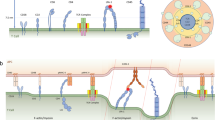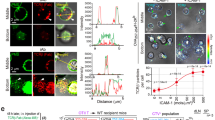Abstract
T cells use secreted soluble factors for highly specific intercellular communication and targeted cell killing. This specificity is achieved first through T cell receptor–mediated recognition of complexes of peptide and major histocompatibility complex displayed by appropriate antigen-presenting cells and then by the directed secretion of cytokines and lytic factors into the immunological synapse between the T cell and antigen-presenting cell. Studies have begun to probe the molecular basis for this synaptic secretion and have also shown that T cells release chemokines and certain inflammatory factors through a multidirectional pathway directed away from the synapse. Thus, the mode of secretion seems to be tailored to the intended function of the secreted molecule.
This is a preview of subscription content, access via your institution
Access options
Subscribe to this journal
Receive 12 print issues and online access
$209.00 per year
only $17.42 per issue
Buy this article
- Purchase on Springer Link
- Instant access to full article PDF
Prices may be subject to local taxes which are calculated during checkout

Kim Caesar

Kim Caesar
Similar content being viewed by others

References
Bromley, S.K. et al. The immunological synapse. Annu. Rev. Immunol. 19, 375–396 (2001).
Grakoui, A. et al. The immunological synapse: a molecular machine controlling T cell activation. Science 285, 221–227 (1999).
Boisvert, J., Edmondson, S. & Krummel, M.F. Immunological synapse formation licenses CD40–CD40L accumulations at T-APC contact sites. J. Immunol. 173, 3647–3652 (2004).
Poo, W.J., Conrad, L. & Janeway, C.A., Jr. Receptor-directed focusing of lymphokine release by helper T cells. Nature 332, 378–380 (1988).
Kupfer, A., Mosmann, T.R. & Kupfer, H. Polarized expression of cytokines in cell conjugates of helper T cells and splenic B cells. Proc. Natl. Acad. Sci. USA 88, 775–779 (1991).
Kupfer, H., Monks, C.R. & Kupfer, A. Small splenic B cells that bind to antigen-specific T helper (Th) cells and face the site of cytokine production in the Th cells selectively proliferate: immunofluorescence microscopic studies of Th-B antigen-presenting cell interactions. J. Exp. Med. 179, 1507–1515 (1994).
Geiger, B., Rosen, D. & Berke, G. Spatial relationships of microtubule-organizing centers and the contact area of cytotoxic T lymphocytes and target cells. J. Cell Biol. 95, 137–143 (1982).
Kupfer, A., Dennert, G. & Singer, S.J. Polarization of the Golgi apparatus and the microtubule-organizing center within cloned natural killer cells bound to their targets. Proc. Natl. Acad. Sci. USA 80, 7224–7228 (1983).
Sedwick, C.E. et al. TCR, LFA-1, and CD28 play unique and complementary roles in signaling T cell cytoskeletal reorganization. J. Immunol. 162, 1367–1375 (1999).
Kuhne, M.R. et al. Linker for activation of T cells, ζ-associated protein-70, and Src homology 2 domain-containing leukocyte protein-76 are required for TCR-induced microtubule-organizing center polarization. J. Immunol. 171, 860–866 (2003).
Martin-Cofreces, N.B. et al. Role of Fyn in the rearrangement of tubulin cytoskeleton induced through TCR. J. Immunol. 176, 4201–4207 (2006).
Ardouin, L. et al. Vav1 transduces TCR signals required for LFA-1 function and cell polarization at the immunological synapse. Eur. J. Immunol. 33, 790–797 (2003).
Combs, J. et al. Recruitment of dynein to the Jurkat immunological synapse. Proc. Natl. Acad. Sci. USA 103, 14883–14888 (2006).
Gomez, T.S. et al. Formins regulate the actin-related protein 2/3 complex-independent polarization of the centrosome to the immunological synapse. Immunity 26, 177–190 (2007).
Faix, J. & Grosse, R. Staying in shape with formins. Dev. Cell 10, 693–706 (2006).
Wen, Y. et al. EB1 and APC bind to mDia to stabilize microtubules downstream of Rho and promote cell migration. Nat. Cell Biol. 6, 820–830 (2004).
Brandt, D.T. & Grosse, R. Get to grips: steering local actin dynamics with IQGAPs. EMBO Rep. 8, 1019–1023 (2007).
Brandt, D.T. et al. Dia1 and IQGAP1 interact in cell migration and phagocytic cup formation. J. Cell Biol. 178, 193–200 (2007).
Stinchcombe, J.C., Majorovits, E., Bossi, G., Fuller, S. & Griffiths, G.M. Centrosome polarization delivers secretory granules to the immunological synapse. Nature 443, 462–465 (2006).
Stowers, L., Yelon, D., Berg, L.J. & Chant, J. Regulation of the polarization of T cells toward antigen-presenting cells by Ras-related GTPase CDC42. Proc. Natl. Acad. Sci. USA 92, 5027–5031 (1995).
Stinchcombe, J.C., Bossi, G., Booth, S. & Griffiths, G.M. The immunological synapse of CTL contains a secretory domain and membrane bridges. Immunity 15, 751–761 (2001).
Berke, G. The CTL's kiss of death. Cell 81, 9–12 (1995).
Huse, M., Lillemeier, B.F., Kuhns, M.S., Chen, D.S. & Davis, M.M. T cells use two directionally distinct pathways for cytokine secretion. Nat. Immunol. 7, 247–255 (2006).
Barcia, C. et al. In vivo polarization of IFN-gamma at Kupfer and non-Kupfer immunological synapses during the clearance of virally infected brain cells. J. Immunol. 180, 1344–1352 (2008).
Reichert, P., Reinhardt, R.L., Ingulli, E. & Jenkins, M.K. Cutting edge: in vivo identification of TCR redistribution and polarized IL-2 production by naive CD4 T cells. J. Immunol. 166, 4278–4281 (2001).
Chen, D.S. et al. Marked differences in human melanoma antigen-specific T cell responsiveness after vaccination using a functional microarray. PLoS Med. 2, e265 (2005).
Jahn, R., Lang, T. & Sudhof, T.C. Membrane fusion. Cell 112, 519–533 (2003).
Parlati, F. et al. Distinct SNARE complexes mediating membrane fusion in Golgi transport based on combinatorial specificity. Proc. Natl. Acad. Sci. USA 99, 5424–5429 (2002).
Augustin, I., Rosenmund, C., Sudhof, T.C. & Brose, N. Munc13–1 is essential for fusion competence of glutamatergic synaptic vesicles. Nature 400, 457–461 (1999).
Chapman, E.R. How does synaptotagmin trigger neurotransmitter release? Annu. Rev. Biochem. 77, 615–641 (2008).
Zerial, M. & McBride, H. Rab proteins as membrane organizers. Nat. Rev. Mol. Cell Biol. 2, 107–117 (2001).
Menasche, G. et al. Mutations in RAB27A cause Griscelli syndrome associated with haemophagocytic syndrome. Nat. Genet. 25, 173–176 (2000).
Stinchcombe, J.C. et al. Rab27a is required for regulated secretion in cytotoxic T lymphocytes. J. Cell Biol. 152, 825–834 (2001).
Clark, R.H. et al. Adaptor protein 3–dependent microtubule-mediated movement of lytic granules to the immunological synapse. Nat. Immunol. 4, 1111–1120 (2003).
Dell'Angelica, E.C., Shotelersuk, V., Aguilar, R.C., Gahl, W.A. & Bonifacino, J.S. Altered trafficking of lysosomal proteins in Hermansky-Pudlak syndrome due to mutations in the beta 3A subunit of the AP-3 adaptor. Mol. Cell 3, 11–21 (1999).
Ma, J.S. et al. Protein kinase Cδ regulates antigen receptor-induced lytic granule polarization in mouse CD8+ CTL. J. Immunol. 178, 7814–7821 (2007).
Krzewski, K., Chen, X. & Strominger, J.L. WIP is essential for lytic granule polarization and NK cell cytotoxicity. Proc. Natl. Acad. Sci. 105, 2568–2573 (2008).
Voskoboinik, I., Smyth, M.J. & Trapani, J.A. Perforin-mediated target-cell death and immune homeostasis. Nat. Rev. Immunol. 6, 940–952 (2006).
Feldmann, J. et al. Munc13–4 is essential for cytolytic granules fusion and is mutated in a form of familial hemophagocytic lymphohistiocytosis (FHL3). Cell 115, 461–473 (2003).
Neeft, M. et al. Munc13–4 is an effector of Rab27a and controls secretion of lysosomes in hematopoietic cells. Mol. Biol. Cell 16, 731–741 (2005).
Bryceson, Y.T. et al. Defective cytotoxic lymphocyte degranulation in syntaxin-11 deficient familial hemophagocytic lymphohistiocytosis 4 (FHL4) patients. Blood 110, 1906–1915 (2007).
Holt, O. et al. Slp1 and Slp2-a localize to the plasma membrane of CTL and contribute to secretion from the immunological synapse. Traffic 9, 446–457 (2008).
Robertson, L.K., Mireau, L.R. & Ostergaard, H.L. A role for phosphatidylinositol 3-kinase in TCR-stimulated ERK activation leading to paxillin phosphorylation and CTL degranulation. J. Immunol. 175, 8138–8145 (2005).
Takayama, H. & Sitkovsky, M.V. Antigen receptor-regulated exocytosis in cytotoxic T lymphocytes. J. Exp. Med. 166, 725–743 (1987).
Schaller, M.D. Paxillin: a focal adhesion-associated adaptor protein. Oncogene 20, 6459–6472 (2001).
Das, V. et al. Activation-induced polarized recycling targets T cell antigen receptors to the immunological synapse; involvement of SNARE complexes. Immunity 20, 577–588 (2004).
Kreitzer, G. et al. Three-dimensional analysis of post-Golgi carrier exocytosis in epithelial cells. Nat. Cell Biol. 5, 126–136 (2003).
Wendler, F. & Tooze, S. Syntaxin 6: the promiscuous behaviour of a SNARE protein. Traffic 2, 606–611 (2001).
Murray, R.Z., Kay, J.G., Sangermani, D.G. & Stow, J.L. A role for the phagosome in cytokine secretion. Science 310, 1492–1495 (2005).
Murray, R.Z., Wylie, F.G., Khromykh, T., Hume, D.A. & Stow, J.L. Syntaxin 6 and Vti1b form a novel SNARE complex, which is up-regulated in activated macrophages to facilitate exocytosis of tumor necrosis factor-α. J. Biol. Chem. 280, 10478–10483 (2005).
Pagan, J.K. et al. The t-SNARE syntaxin 4 is regulated during macrophage activation to function in membrane traffic and cytokine secretion. Curr. Biol. 13, 156–160 (2003).
Morales-Tirado, V. et al. Cutting edge: selective requirement for the Wiskott-Aldrich syndrome protein in cytokine, but not chemokine, secretion by CD4+ T cells. J. Immunol. 173, 726–730 (2004).
Alberts, B. et al. in Molecular Biology of the Cell 5th edn. 711–767 (Taylor and Francis, New York, 2007).
Catalfamo, M. et al. Human CD8+ T cells store RANTES in a unique secretory compartment and release it rapidly after TCR stimulation. Immunity 20, 219–230 (2004).
Okada, T. et al. Antigen-engaged B cells undergo chemotaxis toward the T zone and form motile conjugates with helper T cells. PLoS Biol. (2005).
Taylor, P.C., Williams, R.O. & Feldmann, M. Tumour necrosis factor α as a therapeutic target for immune-mediated inflammatory diseases. Curr. Opin. Biotechnol. 15, 557–563 (2004).
Sancho, D. et al. The tyrosine kinase PYK-2/RAFTK regulates natural killer (NK) cell cytotoxic response, and is translocated and activated upon specific target cell recognition and killing. J. Cell Biol. 149, 1249–1262 (2000).
Chen, X. et al. CD28-stimulated ERK2 phosphorylation is required for polarization of the microtubule organizing center and granules in YTS NK cells. Proc. Natl. Acad. Sci. USA 103, 10346–10351 (2006).
Serrador, J.M. et al. HDAC6 deacetylase activity links the tubulin cytoskeleton with immune synapse organization. Immunity 20, 417–428 (2004).
Huse, M. et al. Spatial and temporal dynamics of T cell receptor signaling with a photoactivatable agonist. Immunity 27, 76–88 (2007).
Acknowledgements
We thank Z. Chai for discussions. Supported by the National Institutes of Health (AI057229 to M.M.D.) and the Howard Hughes Medical Institute (M.M.D.).
Author information
Authors and Affiliations
Corresponding authors
Rights and permissions
About this article
Cite this article
Huse, M., Quann, E. & Davis, M. Shouts, whispers and the kiss of death: directional secretion in T cells. Nat Immunol 9, 1105–1111 (2008). https://doi.org/10.1038/ni.f.215
Published:
Issue Date:
DOI: https://doi.org/10.1038/ni.f.215
This article is cited by
-
High-throughput spatiotemporal monitoring of single-cell secretions via plasmonic microwell arrays
Nature Biomedical Engineering (2023)
-
Plasma membrane LAT activation precedes vesicular recruitment defining two phases of early T-cell activation
Nature Communications (2018)
-
TLR7 mediated viral recognition results in focal type I interferon secretion by dendritic cells
Nature Communications (2017)
-
Image analysis of immune cell patterns in the human mammary gland during the menstrual cycle refines lymphocytic lobulitis
Breast Cancer Research and Treatment (2017)
-
Th17 Cells Induce Dopaminergic Neuronal Death via LFA-1/ICAM-1 Interaction in a Mouse Model of Parkinson’s Disease
Molecular Neurobiology (2017)


